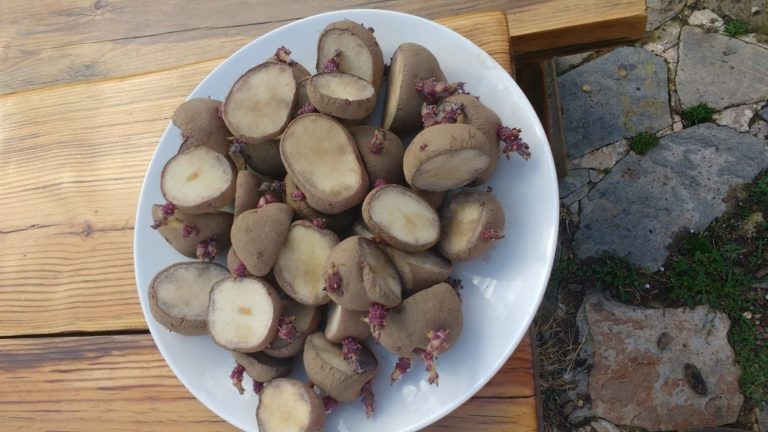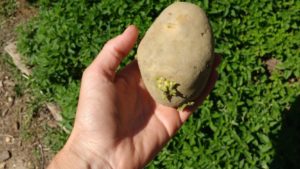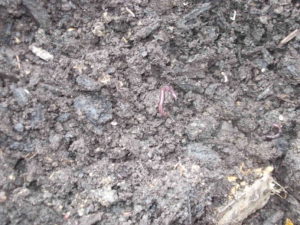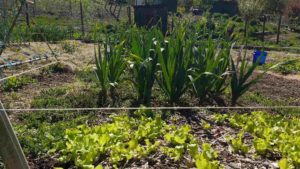Pathogen…. That just sounds like a creepy, scary word. And when you are talking about pathogens in your soil, it really can be.
Irish Potato Famine
You’ve all heard of the Irish Potato Famine, right? A million Irish people died and another million emigrated because the Irish potato crops were decimated by a pathogen called Phytophthora infestans.
When it happened, Irish farmers were growing potatoes about like the rest of us grow weeds. They were so good at it, that the diets of the Irish poor revolved around that one calorie crop. Little did they know that a vicious pathogen was lurking in their soil, biding its time until it had the numbers to totally decimate the Irish food supply.
OK, in reality, the pathogen itself is not quite that menacing. The real reason this was such a big deal was because more diverse food options were not available for a large percentage of the Irish population. (The wealthy had diverse diets; the poor relied on potatoes.)
Additionally, because potatoes were planted prolifically, the pathogen spread quickly through the sharing of seed potatoes (like the way a cold spreads through an office). Once in the soil, it stayed dormant until significant rains sent it into reproductive overdrive and allowed it to infect and thrive in sopping wet potato plants. Heavy rain is to fungal pathogens what dry wind is to an open fire.
How Pathogens Spread
If you grow tomatoes, you are probably familiar with two well-known pathogens commonly called blight and wilt. These pathogens are similar to the Irish potato plant killer. They spread slowly in the soil—usually transmitted by transplants, compost, soil mixes, or even your shoes.
In relatively dry conditions, these pathogens may be present in the soil, but have no impact on your plant. Then one day, you get 2 inches of rain, your soil compacts and doesn’t dry out for days, and leaves turn yellow and drop off. Then, on the next sunny day, your tomatoes get ugly sun scald spots and rot before you can eat them.
Here’s the thing: Pathogens alone present no risks. Many of them are plant specific, which means that unless they come into contact with a suitable host plant, they are harmless. Even when you have the pathogen and the plant in the same place, this will not necessarily result in plant damage.
It’s only when you get a trifecta of conditions that include the right plant, the right pathogen, and environmental conditions suitable for incubation and infestation that problems happen. Here’s a simple mathematical expression for how that works:
Pathogen + Susceptible Plant Host + Optimal Environmental Conditions = Disaster
Remove one of these pieces from the equation, and you can avert disaster. Since you often don’t know the pathogen is present in your soil and you can’t control things like the weather, the most logical way to avert disaster is to take the host plant out of the equation.
Rotate Plants by Family to Reduce Risk
This is where the idea of only planting one family of plants in the same plot once every four (or more) years comes into play. By rotating your plants, you limit the risk for having a trifecta. Also, depending on the life cycle of your pathogen, sometimes without a host plant, the pathogen will disappear over time.
Crop Rotation Slows the Spread
Additionally, with good plant-rotation plans, even if you do occasionally get small infestations of a pathogen, you can slow the spread by not offering host plants in close proximity year to year. Many pathogens are soil bound. They must make their way around on the bodies of soilborne critters, through transplants, on your garden tools, by catching a ride with an airborne insect, etc.
If they can move from host plant to host plant year after year, they can build up more quickly. With no nearby hosts, they remain dormant and pathogen populations remain in check.
Crop Rotation Gives you Time to Identify and Solve Pathogen Problems
Four-year rotations improve your odds by limiting a buildup of pathogens and spreading risk. Longer rotations are even better, since many pathogens can persist in the soil for 10 years or more. However, this can be more difficult to achieve in a small garden.
Luckily, if you do have plants that become infected with a pathogen, four-year crop rotation plans give you time to research and remedy your pathogen before you plant that family in that location again.
Start by identifying the pathogen. Aim to understand its life cycle and avoid planting the susceptible host plant again until you are sure the pathogen is gone.
Depending on your pathogen, there are different strategies you can follow to make your soil safe for planting again. For example, you can plant certain kinds of mustard and till them in. This practice is called biofumigation.
You can solarize your soil. This will kill all the biological life in your soil, too. You’ll need to then build back up your biological life with organic matter inputs.
With some pathogens that have long life spans, you may also need to consider more drastic measures. Replacing your soil, installing equipment to improve drainage, and developing alternate garden areas may be necessary in some instances.
Rotate by Families Prone to Similar Pathogen Problems
Because pathogens tend to affect entire plant families, rotating by family is the most common way to avoid pathogen problems. For example, tomatoes and potatoes might seem like very different plants to us. However, even if they have a preference for tomatoes over potatoes, opportunistic pathogens will take what they can get.
These are the family categories I use in my vegetable plant rotations:
- Nightshade Family: Tomato, Potato, Pepper, Eggplant
- Grass Family: Corn, Sorghum, Wheat
- Lettuce Family: Lettuce, Sunflowers, Dandelion, Chicory, Radicchio
- Beet Family: Beets, Spinach, Chard
- Cole Family: Cabbage, Mustard, Turnips, Arugula, Broccoli, Cauliflower
- Curcurbit Family: Squash, Cucumbers, Melons, Pumpkins
- Legume Family: Peas, Beans, Clover, Alfalfa
- Umbel Family: Carrots, Parsnips, Parsley, Fennel, Celery
- Allium Family: Onions, Garlic, Chives, Shallots
- Miscellaneous: Buckwheat, Okra, Sweet Potato
This is a lot to try to rotate in a small garden. Personally, I lump a few families together to create rotational pairings.
- The nightshade, allium, cole, and sweet potato families tend to take up more space in my garden than the other families. They each get their own rotation.
- I lump the grass, legume, and curcurbit families together in my rotations. I use that grouping because I tend to only need one row of space for those three plant families to one row of sweet potatoes based on how we eat. Sweet potatoes are a calorie crop that we need a lot of. Corn, cucumbers, and even beans (which are hard to grow enough of in useful amounts) are things we grow for fun to add variety to our diets.
Create Interplanting or Seasonal Plant Groupings
As long as you are consistent in your crop rotation methods, you can mix and match your families to get down to a four- or five-year planting rotation cycle.
If you use interplanting in your beds for soil protection, you may want to plan your family rotational groupings using this information. For example, if you grow carrots, radishes, and lettuce in the same bed at the same time, then one of your rotations would include the umbel, cole, and lettuce families.
Once you establish that grouping of families as a rotational pattern, then you can use that information to plan other rotations. You could grow early cabbage, followed by summer sunflowers, and then over-wintering parsnips. Using that same family grouping in different ways, you can achieve more food production while still having distinct rotations geared at preventing pathogens.
If you are following this series, you now have information to help you plan your crop rotation schedules to prevent pests and pathogens. However, there is one more really big reason why you may want to use crop rotation, even in a small garden. It’s for nutrient management. In the next post, we’ll cover that in more detail. Then you can take these three concepts and apply them to growing a more problem-free garden at home.
Read More: “Crop Rotation for the Home Garden, Part 1: Pest Control”
In the meantime, start thinking about what you grow, and the kind of pathogens that are common to your area. Are there any you are particularly worried about? Talk to your local agricultural office and find out what risks may apply to your garden.
If you have any tricks or tips you’ve learned that might help with crop -rotation planning, we’d love to hear from you in the comments section below.

Tasha Greer is a regular contributor to The Grow Network and has cowritten several e-books with Marjory Wildcraft. The author of “Grow Your Own Spices” (December 2020), she also blogs for MorningChores.com and Mother Earth News. For more tips on homesteading and herb and spice gardening, follow Tasha at Simplestead.com.












COMMENTS(4)
Thanks, Tasha. This is just the kind of information I need to get into. I mostly deal with weeds, so I’m not as good with “real” gardens. 😉
Scott – I suspect it takes a lifetime to become good with “real gardens”. I know lots of home vegetable growers who have been at it for thirty-plus years. They still have failures every year and keep making improvements to their practices. In the meantime, grow some beets, turnips, and crookneck squash – they’ll make you feel like a rock star at vegetable gardening – and give you lots of good stuff to eat!
Great article Tasha! I like how you’ve lumped some families together. I’m gonna start implementing this!
Thanks Brian! Hope it works well for you. Report back on your groupings if you get a chance. I’d love to hear what works for you.